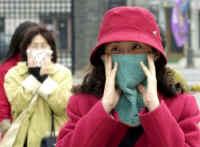Wed Mar 20,2002
BEIJING - Wind-whipped sandstorms slapped a ghostly haze onto the capital and across swaths of northern China on Wednesday, turning day into yellowy dusk and inflaming the lungs and eyes of millions.
A fierce sandstorm blows across the tarmac as the plane carrying Japanese Prime Minister Junichiro Koizumi arrives at Seoul military airport March 21, 2002. Sandstorms blowing in from China disrupted some domestic flights, slowing down work in shipyards and confining many people to their homes or offices. Koizumi arrived in Seoul on Thursday for a three-day visit. REUTERS/Kim Kyung-Hoon
Authorities advised people to stay indoors to guard themselves from clouds so thick they obscured the renowned portrait of Mao Zedong on Tiananmen Square.
"This is so much worse than last year," said a doorman working in an apartment building in Chaoyang, Beijing's embassy district. He looked out upon a neighborhood of streets all but deserted as fine grains of said whirled around.
Anyone who inhaled got a mouthful of dust that had traveled from as far as Mongolia's Gobi Desert. Beijing police stepped up traffic controls as visibility dropped to less than 100 yards. Cyclists covered their mouths with a hand; children walked with their shirts, coats and anything else they could find pulled over their noses.
Some women wore translucent scarves and even see-through cloth bags over their heads as the storm worsened.
Wang Hongsheng, who has lived in Beijing for more than six decades, told the official Xinhua News Agency he couldn't recall such a severe "shachenbao," or "sand-dust tempest," in recent years. "I remember seeing such sandstorms in the old days," he said.
China's State Forestry Administration said 130 million people across 540,500 square miles of northern China were affected by the dust storm. Government meteorologists blamed severe drought in recent months for exacerbating matters.
On Wednesday evening, state television gave extensive coverage of the dust, showing footage of crews feverishly hosing down dirt piles at construction sites to prevent more grime from being whipped up.
Dust storms choke northern China nearly every spring, often blown off the dry expanses of the Mongolian desert plain. But the problem has grown worse in the past 20 years because of deforestation and the increased drought across the north.
The first "shachenbao" of 2002 struck Beijing this weekend. The latest, expected to last until Thursday, blanketed a vast chunk of land from northwestern China's Gansu province to the eastern seaboard, state media reported.
In Inner Mongolia, part of northern China, bright halogen streetlights were illuminated at midday but managed to only partially cut through the haze. To the north, in the country of Mongolia, some highways were closed because of the one-two punch of sand and wind.
In parts of Gansu, visibility dropped to zero Tuesday, Xinhua said.
Despite the dust, flights at Beijing's International Airport were unaffected Wednesday, officials said.
Meteorologists said the storm would have been even worse were it not for rain that fell Wednesday morning -- itself an unusual event in parched Beijing. The rain mixed with the dust, covering cars with little dollops of mud.
http://story.news.yahoo.com/news?tmpl=story&u=/ap/20020320/ap_on_re_as/china_dust_storms
Category: Accounts of Persecution






